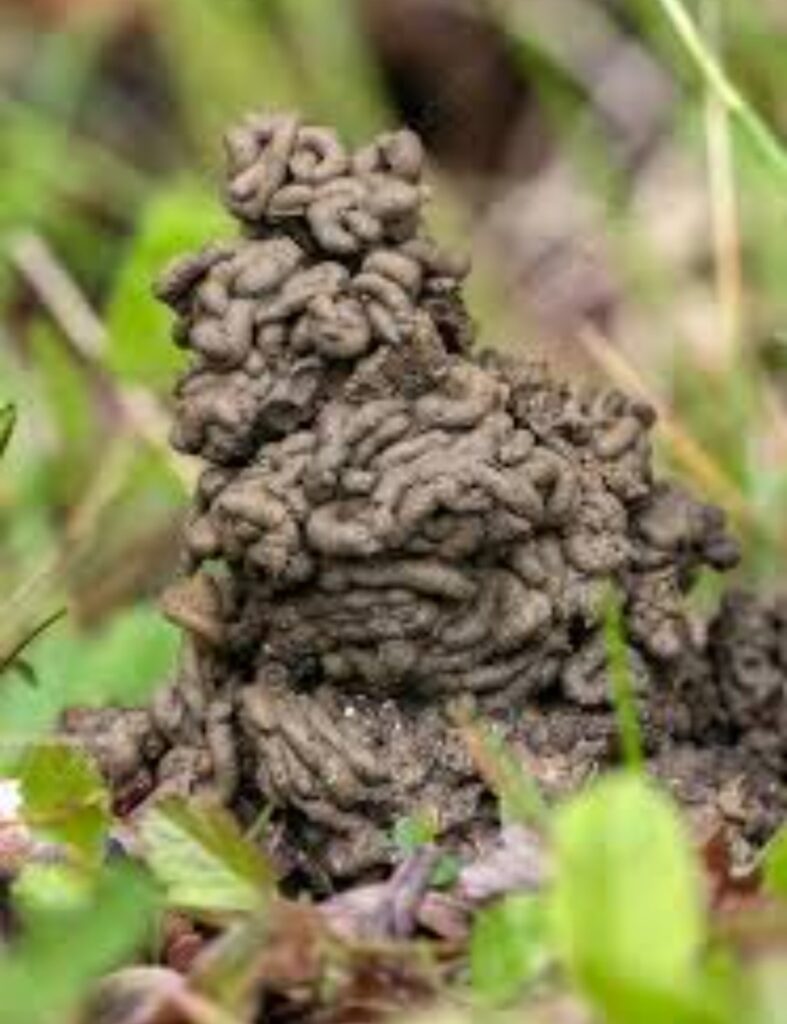
Earthworms are found in almost every soil and their environment. Other slang names for earthworms include “dew-worm”, “rainworm”, “nightcrawler”, and “angleworm” (from its use as angling hookbaits).
They belong to the Kingdom Animalia, phylum Annelida, class Clitellata or Oligochaeta, order Haplotaxida or Opisthopora and suborder Lumbricina. All earthworms belong to either of the following families; Tubificidae, Lumbricidae and Enchytraeidae. Other families still exist apart from the above.
They are most abundant in forests and grasslands of temperate and tropical regions. They feed on soil, specifically decaying animal and plant matter, any organic matter they encounter, fungi, bacteria, or any other organism small enough to be eaten. Their digestive tract is one way, they eat with their mouth on one end and excrete waste at the other end of their body. The same muscles that allow for their movement through soil also push their food through their digestive system.
There is no male or female earthworm. They are hermaphrodites. Each worm carries male and female reproductive organs and genital pores. When mating, two individual earthworms will exchange sperm and fertilize each other’s ova. The male pores opened posterior to the female pores, although the internal male segments are anterior to the female.
They play an important role within the soil community.
Earthworms prefer moderate soil temperatures, so they are more active near the surface during mild weather. When things are too hot or too cold, they will move deeper into the soil. Once conditions change, they will rise again and feast on the organic matter close to the surface, leaving casts behind. The casts are soil mounds formed from finely processed soil that has passed through the worm’s stomach.
Larger terrestrial earthworms are called megadriles (which translates to “big worms”) as opposed to the microdriles (“small worms”) in the semiaquatic families. The megadriles are characterized by a distinct clitellum (more extensive than that of microdriles) and a vascular system with true capillaries.

SPECIES OF EARTHWORMS
Amynthas mekongianus
Aporrectodea limicola,
Arctiostrotus vancouverensis
Australian Didymogaster sylvaticus (known as the “blue squirter earthworm”)
Criodrilus lacuum
Eisenia fetida .
Lampito mauritii
Lumbricus terrestris
Perionyx excavatus
Pontodrilus litoralis
Sparganophilus spp,
Some of the different families earthworms species belong to include;
Acanthodrilidae
Ailoscolecidae
Almidae
Octochaetidae
Criodrilidae
Diplocardiinae Acanthodrilidae
Enchytraeidae
Eudrilidae
Exxidae
Glossoscolecidae
Haplotaxidae
Hormogastridae
Kynotidae
Lumbricidae
Lutodrilidae
Megascolecidae
Microchaetidae
Moniligastridae
Ocnerodrilidae
Octochaetidae
Octochaetinae
Sparganophilidae
Tumakidae
DESCRIPTION OF EARTHWORMS
Earthworm has a long cylindrical tube-in-a-tube shape with segmented body. The cylindrical body is divided into a series of segments (called metameres) that compartmentalize the body. The external body tube and the internal body part is segmented.
It possess a dorsal pores and nephridiopores which exude a fluid that moistens and protects the worm’s surface, allowing it to breathe. Except for the mouth and anal segments.
The internal segments usually have setae on all segments. The lateral septal are like bristlelike hairs used to anchor parts of the body during movement. Special ventral setae are used to anchor mating earthworms by their penetration into the bodies of their mates.
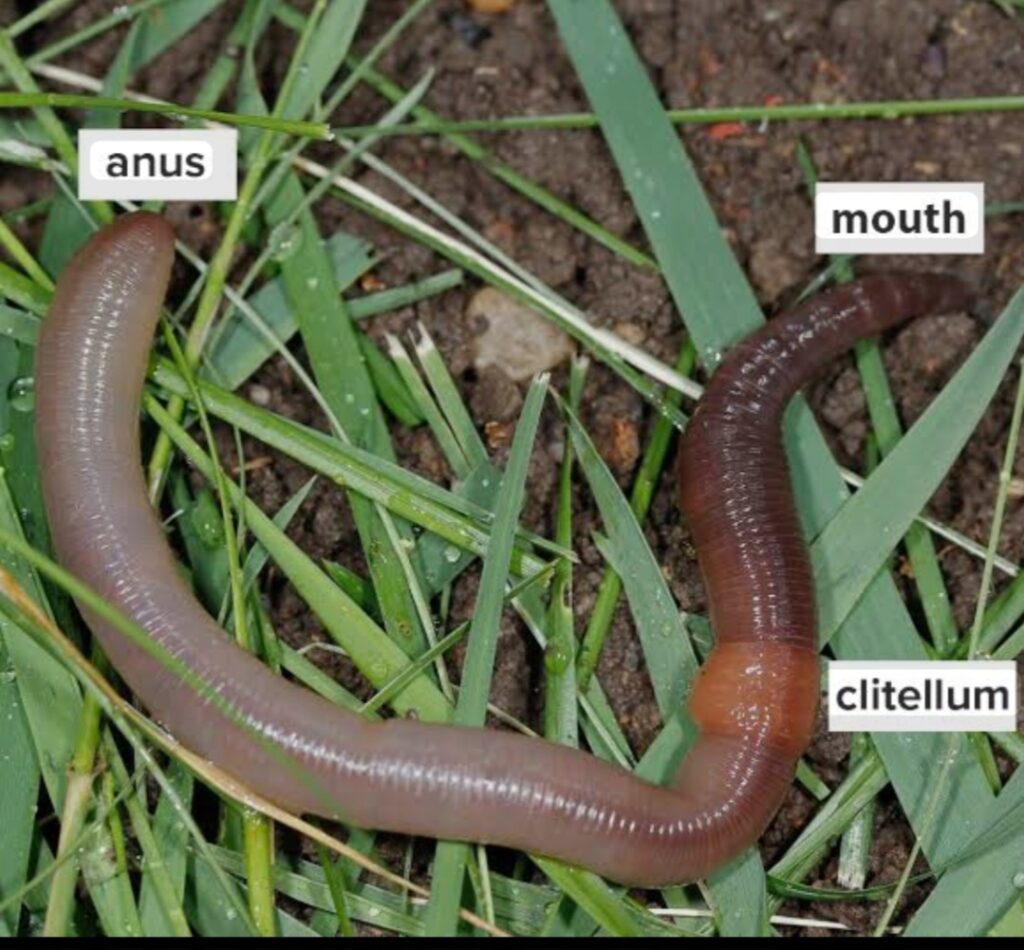
They have a cosmopolitan distribution wherever soil, water and temperature conditions allow. They have a double transport system made of coelomic fluid that moves within the fluid-filled coelom and a simple, closed circulatory system, and respire (breathe) through cutaneous respiration.
As soft-bodied invertebrates, they lack a true skeleton, but their structure is maintained by fluid-filled coelom chambers that function as a hydrostatic skeleton.
The first body segment (segment number 1) which features the mouth and, overhanging the mouth, a fleshy lobe called the prostomium, which seals the entrance when the worm is at rest, but is also used to feel and chemically sense the worm’s surroundings. Some species of earthworm can even use the prehensile prostomium to grab and drag items such as grasses and leaves into their burrow.
EARTHWORM SIZES
The larger terrestrial earthworms are called megadriles while the microdriles are the “small worms”.
They are commonly found in moist, compost-rich soil. They feed on a wide variety of organic matters, including detritus, living protozoa, rotifers, nematodes, bacteria, fungi and other microorganisms.
An adult earthworm develops a belt-shaped glandular swelling, called the clitellum, which covers several segments toward the front part of the animal. This is part of the reproductive system and produces egg capsules. The posterior is most commonly cylindrical like the rest of the body, but depending on the species, it may also be quadrangular, octagonal, trapezoidal, or flattened. The last segment is called the periproct; the earthworm’s anus, a short vertical slit, is found on this segment.

CLASSIFICATION OF EARTHWORMS
From a total of 7,000 species, only about 150 species of earthworms are widely distributed around the world. These are the peregrine or cosmopolitan earthworms.
Earthworms are often classified into a few basic categories, based on morphology, feeding habits, and their microhabitats within the soil. These categories include; epigeic, endogeic, and anecic. Apart from these,
earthworms can also be classified into three main ecophysiological categories. The leaf letter or compost dwelling worms, to- soil or subsoil dwelling worms and worms that construct permanent dwelling burrows.
A. a. EPIGEIC EARTHWORMS
Epigeic Earthworms tend to be the smallest of the three, less than 10 cm, and the most pigmented. They live mainly on leaf litter or surface soil and eat litter and small microbes. These worms might make temporary small tunnels through the litter and topsoil.
b. ENDOGEIC EARTHWORM
Endogeic Earthworms are moderately sized and unpigmented. They inhabit the mineral level of the soil, ranging from 0-80 cm below ground. Subcategories of endogeic earthworms are: Polyhumic, Mesohumic, Endo-anecic, and Oligohumic. These all inhabit slightly different zones with different organic matter content.
SUBCATEGORY CLASSIFICATION OF ENDOGEIC EARTHWORM
i. POLYHUMIC WORMS: They live on surface soil or in the root zone and prefer soil with high organic content. They are small-sized, less than 15 cm. They tend to make temporary horizontal burrows.
ii. MESOHUMIC WORMS: They live in soil depths of 0-20 cm and feed on soil from depths of 0-10 cm. These worms make extensive horizontal burrows and are of medium size, 10-20cm.
iii. ENDO-ACECIC WORMS: They live in depths of 0-50 cm, and some make more permanent burrows. They feed on soil from depths of 0-10 cm. They are greater than 20cm in length.
iv. OLIGOHUMIC WORMS: They live in depths of 15-80 cm and feed on soil from depths of 20-40 cm. They are greater than 20 cm in length and tend to be the largest out of all of these categories.
c. ANECIC EARTHWORMS
These worms live in permanent burrows in the soil. They feed on surface leaf litter that they drag deep into their burrows, as well as soil from any depth they encounter. They are dorsally pigmented (i.e. their back is pigmented) and are greater than 15 cm.
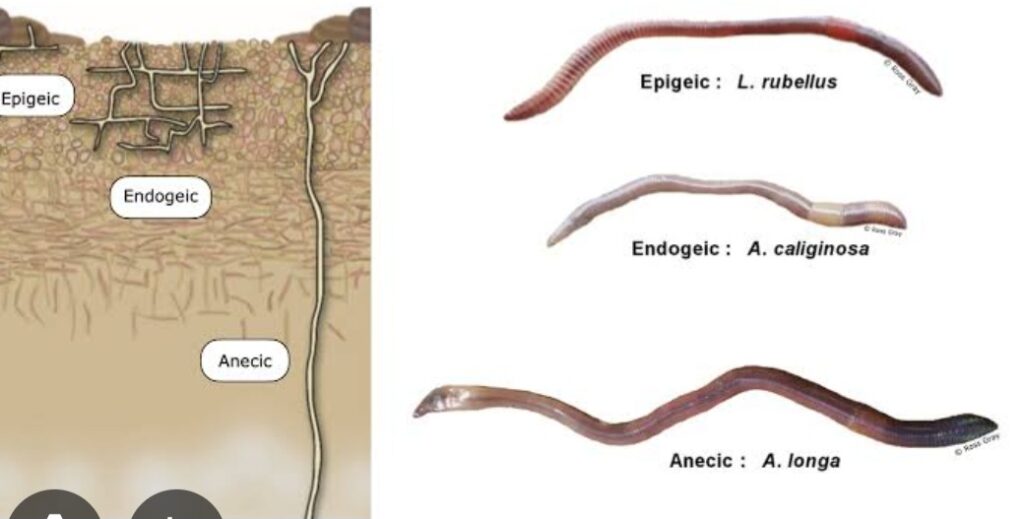
B. CLASSIFICATION BASED ON ECOPHYSIOLOGICAL CATEGORIES
(1) LEAF LITTER- or COMPOST-DWELLING WORMS: They are nonburrowing, live at the soil-litter interface and eat decomposing organic matter (epigeic) e.g. Eisenia fetida;
(2) TOPSOIL- OR SUBSOIL-DWELLING WORMS: They feed (on soil), burrow and cast within the soil, creating horizontal burrows in upper 10–30 cm of soil (endogeic); and
(3) Worms that construct permanent deep vertical burrows which they use to visit the surface to obtain plant material for food, such as leaves (anecic, meaning “reaching up”), e.g. Lumbricus terrestris.

BENEFITS OF EARTHWORMS
1. The earthworm activity aerates and mixes the soil,
2. They assist in the mineralization of nutrients and their uptake by vegetation.
3. Certain species of earthworm come to the surface and graze on the higher concentrations of organic matter present there, mixing it with the mineral soil. Because a high level of organic matter mixing is associated with soil fertility, an abundance of earthworms is generally considered beneficial by farmers and gardeners.
4. Earthworms are environmental indicators of soil health.
4. Earthworms feed on the decaying matter in the soil and analyzing the contents of their digestive tracts gives insight into the overall condition of the soil.
5. The earthworms are good bioremediators. Through their gut, they accumulate chemicals, including heavy metals such as cadmium, mercury, zinc, and copper.
6. INDICATOR OF SOIL QUALITY: The population size of the earthworm indicates the quality of the soil, as healthy soil would contain a larger number of earthworms.
7. In many soils, earthworms play a major role in the conversion of large pieces of organic matter into rich humus, thus improving soil fertility. This is achieved by the worm’s actions of pulling below the surface deposited organic matter such as leaf fall or manure, either for food or to plug its burrow. Once in the burrow, the worm will shred the leaf, partially digest it and mingle it with the earth. 9. Worm casts can contain 40 percent more humus than the top 9 inches (230 mm) of soil in which the worm is living.
8. FAECES IN THE FORM OF CASTS: In addition to dead organic matter, the earthworm also ingests any soil particles that are small enough—including sand grains up to 1⁄20 inch (1.3 mm)—into its gizzard, wherein those minute fragments of grit grind everything into a fine paste which is then digested in the intestine. When the worm excretes this in the form of casts, deposited on the surface or deeper in the soil, minerals and plant nutrients are changed to an accessible form for plants to use. Investigations in the United States show that fresh earthworm casts are five times richer in available nitrogen, seven times richer in available phosphates, and 11 times richer in available potassium than the surrounding upper 6 inches (150 mm) of soil. In conditions where humus is plentiful, the weight of casts produced may be greater than 4.5 kilograms (9.9 lb) per worm per year.
9. PHYSICAL: The earthworm’s burrowing creates a multitude of channels through the soil and is of great value in maintaining the soil structure, enabling processes of aeration and drainage.
10. AERATION OF SOIL:
Earthworm tunnels act as an air pump which allows air in and out of the soils on a 24-hour cycle (more rapidly at night)”.
11. IMPROVES SOIL HEALTH: The earthworm not only creates passages for air and water to traverse the soil, but also modifies the vital organic component that makes a soil healthy ( Bioturbation).
12. Earthworms promote the formation of nutrient-rich casts (globules of soil, stable in soil mucus) that have high soil aggregation and soil fertility and quality.
13. In podzol soils, earthworms can obliterate the characteristic banded appearance of the soil profile by mixing the organic (LFH), eluvial (E) and upper illuvial (B) horizons to create a single dark Ap horizon.
14. Earthworms accelerate nutrient cycling in the soil-plant system through fragmentation & mixing of plant debris – physical grinding & chemical
15. GOOD IN RESTORATION OF LOST NUTRIENTS: The ability to break down organic materials and excrete concentrated nutrients makes the earthworm a functional contributor in restoration projects. In response to ecosystem disturbances, some sites have utilized earthworms to prepare soil for the return of native flora. Research from the Station d’écologie Tropicale de Lamto asserts that the earthworms positively influence the rate of macroaggregate formation, an important feature for soil structure. The stability of aggregates in response to water was also found to be improved when constructed by earthworms.
15. CONTRIBUTOR TO GLOBAL WARMING: Though not fully quantified yet, greenhouse gas emissions of earthworms is likely contributing to global warming, especially since top-dwelling earthworms increase the speed of carbon cycles and have been spread by humans into many new geographies.
16. Earthworms provide an excellent source of protein for fish, fowl, and pigs, but have also been used traditionally for human consumption. Noke is a culinary term used by the Māori of New Zealand to refer to earthworms, which they consider delicacies for their chiefs.
17. Earthworms play very important roles in soil formation and processes.
18. Earthworms are one of the most important detritivores and coprophages, and also serve as food for many low-level consumers within the ecosystems.
EARTHWORM HABITATS
The main habitat of earthworms is in soil, they are not restricted to this habitat. Earthworm like Eisenia fetida lives in decaying plant matter and manure. Arctiostrotus vancouverensis are generally found in decaying conifer logs. Aporrectodea limicola, Sparganophilus spp., and several others are found in mud and in streams. Some species are arboreal, some aquatic and some euryhaline (salt-water tolerant) and littoral (living on the sea-shore for example, Pontodrilus litoralis. Even in the soil species, special habitats, such as soils derived from serpentine, have an earthworm fauna of their own.
To obtain an appreciable amount of casts, earthworm population must be considered. The Earthworm population depend on both physical and chemical properties of the soil, such as temperature, moisture, pH, salts, aeration, and texture, as well as available food, and the ability of the species to reproduce and disperse. One of the most important environmental factors is pH, but earthworms vary in their preferences. They prefer a neutral to slightly acidic soils. Lumbricus terrestris is still present in a pH of 5.4, Dendrobaena octaedra at a pH of 4.3 and some Megascolecidae are present in extremely acidic humic soils. Soil pH may also influence the numbers of worms that go into diapause. The more acidic the soil, the sooner worms go into diapause, and remain in diapause the longest time at a pH of 6.4.
EXCRETORY SYSTEM OF EARTHWORM
The excretory system contains a pair of nephridia in every segment, except for the first three and the last segment. There are three types of nephridia, namely:
a. integumentary
b. septal, and
c. pharyngeal.
a. INTEGUMENTARY NEPHRIDIA: This nephridia lies and being attached to the inner side of the body wall in all segments except the first two.
b. SEPTAL NEPHRIDIA : These are attached to both sides of the septa behind the 15th segment.
c. THE PHARYNGEAL NEPHRIDIA: These are attached to the fourth, fifth and sixth segments.
The waste in the coelom fluid from a forward segment is drawn in by the beating of cilia of the nephrostome. From there it is carried through the septum (wall) through a tube which forms a series of loops entwined by blood capillaries that also transfer waste into the tubule of the nephrostome. The excretory wastes are then finally discharged through a pore on the worm’s side.
REPRODUCTION IN EARTHWORM
Earthworms have both male and female sexual organs, but still need a partner to reproduce. The clitellum is the slightly discoloured segment about one-third of the body length away from the head that produces mucous that aids with mating. The worms line up in opposite directions and exchange sperm, using the excreted mucous as a protectant/pathway. The sperm is then stored in sperm sacs and later released along with the eggs into cocoons secreted from the mucous of the clitellum. This forms the lemon-shaped cocoons to the right, which can have one or more embryos inside, depending on the species. New earthworms emerge from these cocoons in a few weeks, depending on the species.
EARTHWORM CAST
Earthworm casts, also known as worm castings or worm poop, are the waste products of earthworms. These castings are dark, granular material rich in nutrients and beneficial microbes, making them a valuable addition to soil for improving plant growth and overall soil health.
Earthworm casts are formed
when the earthworms consume organic matter (like decaying leaves and plant material) and soil, then excrete it in the form of casts.
The Castings formed depend on the type of earthworm and their feeding habits.
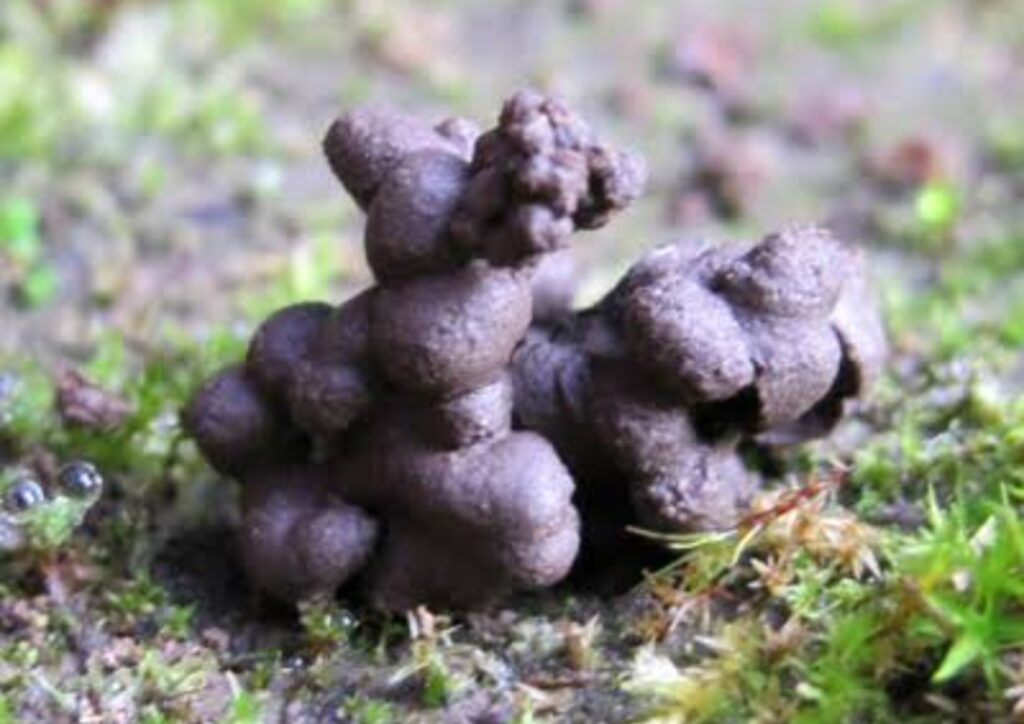
COMPOSITION OF THE CAST
Casts are rich in nutrients like nitrogen, phosphorus, potassium, and calcium, as well as beneficial bacteria and other microorganisms. They also contain humic acid, which helps with nutrient availability to plants.
BENEFITS OF EARTHWORM CAST
1. IMPROVE SOIL STRUCTURE: Casts help to aggregate soil particles, creating a more porous and well-aerated soil structure that improves water infiltration and drainage.
2. ENHANCE PLANT GROWTH: The nutrients and beneficial microbes in casts promote healthy plant growth and development.
3. NUTRIENT CYCLING: Earthworms and their casts play a crucial role in nutrient cycling in the soil, making nutrients more readily available to plants.
4. WATER RETENTION: Casts can improve the soil’s ability to retain water, reducing the need for frequent watering.
5. USED IN GARDENS:
Earthworm casts are a popular natural fertilizer and soil amendment, often used in vegetable gardens, flowerbeds, and lawns.
6. High earthworm populations have three beneficial effects with regard to ameliorating Soil Water Repellent ( SWR):
a. They mix water-repellent topsoil with non-water-repellent subsoil through their mixing activities. b. Worm casts provide organic matter of high quality that have a priming effect on microbial activities. This means worm casts enhance microbial activities which in turn increase the decomposition of organic substances including hydrophobic organic substances.
c. Earthworm burrows will also increase water infiltration rates into hydrophobic soils and thereby reduce overland flow.
7. Low worm populations are often associated with low calcium levels. For example, a research reported that soils with the highest degree of hydrophobicity at Maraetotara (Hawke’s Bay, New Zealand) had pH levels of 3–4 and earthworms cannot survive in these conditions. Adding organic material and liming (adding the macro-nutrient calcium) will, for example, encourage earthworms.
8. Soil moisture and temperature can be optimized through aeration of water-repellent topsoils.
CAST FORMATION
The largest effects of earthworms are making of burrows, as well as digestion of soil and castings. Earthworms of the endogeic and anecic variety make systems of burrows underground, both horizontal and vertical. These burrows, whether temporary or permanent, are a source of aeration for the soil and improve water intake by the soil.
Apart from these casting being formed on top of the soil, They also line the walls of the burrows created. Casts are made as earthworms ingest mineral soil and/or organic matter, then mix them in the gut. This is mixed with gut secretions from the earthworm that enrich it. As earthworms digest soil, the soil is colonized in the their gut, acting on by the microbes that live there. When the cast is excreted, the microbes continue to live on or in it. This makes earthworm burrows a “hot-spot” for microbial activity, and are thus named the Drilosphere. The earthworms excrete this mixture as either a slurry or separate pellets. These could be within or on top of the soil, depending on the worm category. Earthworm excretions have a high organic matter content, and thus enrich the soil around them and increase fertility. Experiments found that on long-term, no-till soil from the drilosphere, that the soil was enriched in NO3−, NH4+ and soluble organic C. These soils hosted far greater populations of nitrifying and denitrifying bacteria when compared to nondrilosphere soil.
Formation of worm cast
The casts are usually formed on soil surface and the amount of moisture present at the soil surface contributes to how big a earthworm casts can make.
Worms feed on plant debris (dead roots, leaves, grasses, manure) and soil. They possess digestive system through which the soil and dead decayed matter they consume pass through. As the materials passes through the digestive system, they become concentrated with organic and mineral constituents which are passed out to form the cast. Thus, making their casts to be rich in available nutrients than the soil around them. Nitrogen in the casts is readily available to plants. Apart from this, when the worms die, their body decomposes rapidly to contribute to the nitrogen content of soil. It is reported that worm casts release four times more phosphorus than surface soil. Worms often leave their nutrient-rich casts in their tunnels, providing a favourable environment for plant root growth. The tunnels also allow roots to penetrate deeper into the soil, where they can reach extra moisture and nutrients. Earthworm tunneling can help incorporate surface applied lime and fertilizer into the soil.
CLASSIFICATION OF EARTHWORM CAST
The fecal pellets produced by earthworms ( Earthworm casts) are generally classified into three main types:
a. pellet casts
b. turret casts, and
c. mass casts.
These different types are linked to the ecological groups of earthworms (epigeic, endogeic, and anecic), which are further categorized by their feeding habits and burrowing behavior.
a. PELLET CASTS:
These are small, granular casts, often found on soil surface. They are typically associated with epigeic earthworms, which live primarily in the topsoil and feed on organic matter.
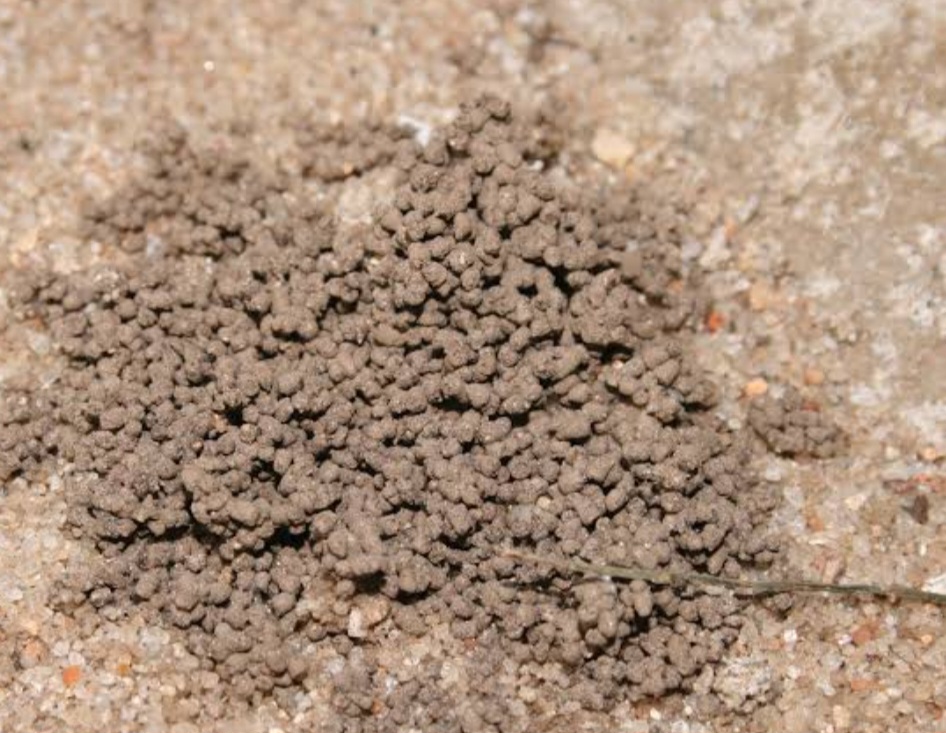
b. TURRET CASTS:
These are vertical, cylindrical casts that are often found at the entrance of earthworm burrows. They are typically associated with anecic earthworms, which dig deep, produce vertical burrows and bring soil to the surface.
c. MASS CASTS:
These are large, irregular masses of soil, often found within the soil profile. They are typically associated with endogeic earthworms, which create extensive horizontal burrows in the soil.

Great breakdown of AI tools! It’s impressive how platforms like AI Video Generation streamline access to so many innovative solutions for professionals and startups.
Hi, thank you for reaching out to us. We appreciate you. Supremelights will surely look into your product and see areas it can profer solutions on our posts. If you have any area of concern based on the posts or any area you want Supremelights to address, please feel free to reach out to us.
Thank you once again.
Bye